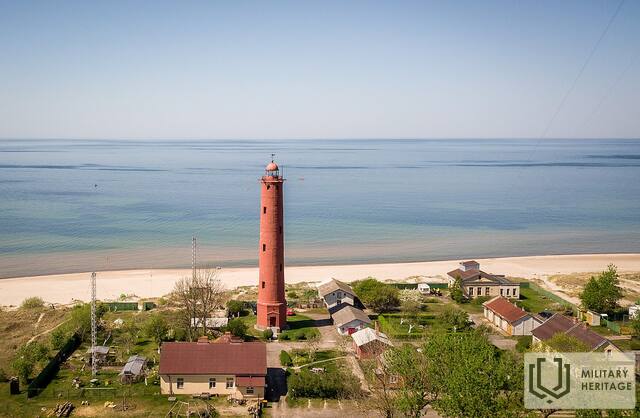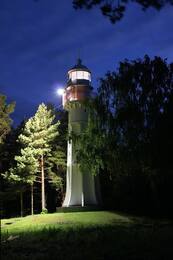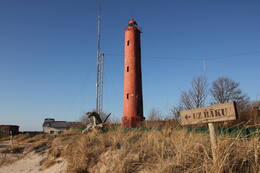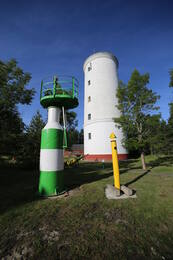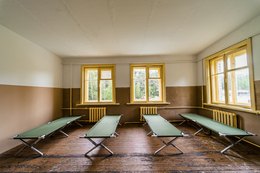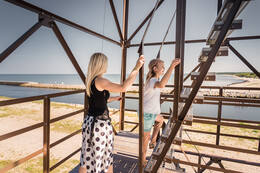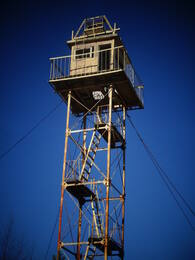Draudžiami švyturiai ir pakrantė
SSRS laikais Šiaurės ir Vakarų Kuržemės pakrantė iš tikrųjų buvo karinė zona, uždaryta visuomenei, tačiau buvo draudžiama lankytis švyturiuose ar net fotografuoti.
Kai jūrų istorijos ir švyturių tyrinėtojas Arvis Pope nusprendė parašyti savo pirmąją knygą apie švyturius, jam teko keliauti po uždraustą Kuršo pakrantę su specialiai išduotu leidimu ir, žinoma, norėjo fotografuoti švyturius. Tačiau oficialiai tai buvo draudžiama, nes švyturiai buvo kariniai objektai, juos stebėjo to meto pasieniečiai ir apsaugos struktūros. Jam teko bandyti tai padaryti slapta, slėptis krūmuose ir miško medžiuose. Be to, fotojuostas reikėjo skubiai keisti ir slėpti. Kitaip tariant, reikėjo elgtis kaip šnipų filme. Mat šalia švyturių buvo pasieniečių daliniai ir, pasirodo, net Kolkos kyšulyje nebuvo patartina rodytis su fotoaparatu.
Paviluosto pusėje buvo taip – Arvis paklausė vyro, kuris dirbo su šluota – pasakyk man, kur galima išeiti ir saugiai vaikščioti pajūriu? Vyras gudriai nusišypsojo ir pasakė – jei eisi į dešinę, jie tave įspės ir tada šaus. Bet jei eisi į kitą pusę – jie šaudys be perspėjimo, ten yra raketininkų!
Ten pat, Paviluostoje, jie nuėjo į knygyną ir lentynoje pamatė Latvijos žemėlapį. Kadangi jų žemėlapis jau buvo gerokai suplyšęs ir nusidėvėjęs, nusprendė nusipirkti naują sau. Taip pat nupirko dar vieną savo kaimynui Rygoje. Išėję iš knygyno, netyčia atsigręžė ir vitrinoje pastebėjo pardavėją. Ji jau buvo su kažkuo pasikalbėjusi telefonu, toliau atidžiai stebėjo užsienio pirkėjus ir užsirašė atvykusio automobilio valstybinį numerį.
Arvi Pope knyga apie švyturius Žvaigždžių pakrantėje buvo išleista 1985 m., ir stebuklingai, švyturių nuotraukos knygoje liko necenzūruotos. Panašu, kad cenzoriai buvo nekompetentingi, kai reikėjo užtikrinti švyturių slaptumą.
Susijusi laiko juosta
Susijusios vietos
Mērsrago švyturys ir buvęs pasienio sargybinis
Mērsrago švyturys yra Mērsrago kaime, apie 1 km į šiaurę nuo kaimo centro. Švyturys buvo pradėtas eksploatuoti 1875 m. Tai 18,5 m aukščio laisvai stovintis, cilindro formos, kniedėmis sutvirtintas geležinis bokštas, kurio apatinė dalis sustiprinta gelžbetoniniais kontraforsais. Signalinio žibinto aukštis – 21,3 m. Viršuje aplink bokštą yra geležinis balkonas, paremtas konsolėmis. Švyturio bokštą pagamino „Sotera, Lemonier & Co“ Paryžiuje, todėl šis švyturys dažnai vadinamas „prancūziškuoju“. 1944 m. pabaigoje šalia švyturio buvo dislokuota Vokietijos armijos 1003-ioji artilerijos divizijos baterija su 60 cm prožektoriais. 1945 m. gegužę nacistinės Vokietijos vyriausioji vadovybė planavo perkelti į šią vietovę 15-ąją Latvijos SS grenadierių diviziją, tačiau šie planai žlugo, nes Latvijos kareiviai pasidavė Vakarų sąjungininkams. Netoli Mērsrago švyturio išlikę pastato, kuriame SSRS laikais sovietų pasieniečiai turėjo didelį, ištraukiamą prožektorių jūrai apšviesti, liekanos. Šalia švyturio yra paukščių stebėjimo bokštelis. Ekskursijas reikia užsisakyti iš anksto susisiekus su Mērsrago turizmo informacijos centru.
Akmeņrago švyturys ir „Saratovo“ likimas
Akmeņrago švyturys yra Sakos valsčiuje, 10 kilometrų į pietvakarius nuo Paviluostos. Į švyturio viršūnę galima patekti spiraliniais laiptais, iš jos atsiveria vaizdas į jūrą ir aplinkinius miškus. Dabartinis 37 metrų aukščio švyturio bokštas buvo pastatytas 1921 m., o ankstesnis švyturys buvo sunaikintas per Pirmąjį pasaulinį karą.
Akmeņrago švyturys išsiskiria iš kitų Latvijos švyturių, nes yra vienoje pavojingiausių laivybai vietų visoje Baltijos jūros pakrantėje. Švyturio signalinis spindulys žymi uolėtą krantą, kuris šiaurės vakarų kryptimi tęsiasi maždaug dvi jūrmyles arba 3,7 kilometro į jūrą. Kranto gylis yra kiek daugiau nei du metrai. Švyturio vieta nepakito, tačiau pakrantė bėgant metams tolsta. Nors navigacijos šviesa čia yra nuo 1879 m., Akmeņrage įvyko keletas laivų avarijų. Žymiausia įvyko 1923 m. rugsėjį, kai į seklumą atsitrenkė Latvijos garlaivis „Saratow“. 1919 m. Saratovas trumpai buvo Latvijos laikinosios vyriausybės būstinė. Akmeņrage anksčiau buvo pasienio apsaugos postas, čia galima apžiūrėti sovietų armijos pastatus.
Oviši švyturys ir sovietinė pasienio apsauga
Ovišų švyturys yra Tārgalės valsčiuje, Ovišų kaime, Kuržemės pakrantėje. Jis buvo pastatytas 1814 m. ir yra seniausias švyturys Latvijoje. Ovišų švyturio bokšto aukštis yra 37 m. Švyturys yra dvigubo cilindro konstrukcijos: jo skersmuo yra 11,5 m, tačiau akmeninėje sienoje yra antras bokštas, kurio skersmuo yra 3,5 m. Tokie dvigubo cilindro švyturiai XVIII–XIX a. Europoje taip pat buvo naudojami kaip gynybiniai statiniai priešo atakų atveju. Ovišų švyturio muziejus laikomas didžiausia švyturio įrangos ir jūrų navigacijos daiktų kolekcija tarp visų Latvijos švyturių muziejų. Geru oru iš Ovišų švyturio galima pamatyti Irbės švyturį.
Antrojo pasaulinio karo pabaigoje netoli Ovišų švyturio buvo įsikūręs Vokietijos armijos Bemingerio bataliono štabas kartu su 530-osios jūrų artilerijos divizijos 4-ąja baterija su keliais priešlėktuviniais pabūklais. Pasakojama, kad švyturio papėdėje buvo radijo krypties ieškiklis ir infraraudonųjų spindulių aptikimo stotis „Donau Gerät“. Netoli švyturio kadaise buvo įsikūręs sovietinis pasienio apsaugos postas, tačiau nė vienas sovietmečio pastatas neišliko. Ovišų stoties pastatas vis dar yra švyturio teritorijoje.
Sovietų armijos karinė bazė Paviluostoje – aktyvaus poilsio centras
Sovietmečiu čia buvo dislokuotas pasienio apsaugos dalinys, už kelių kilometrų miške buvo įsikūrę kiti sovietų armijos daliniai – ryšių karininkai ir žemė-oras raketų bazė. Atkūrus nepriklausomybę, čia buvo dislokuota Latvijos kariuomenė.
Buvusi sovietinės armijos karinė bazė dabar yra poilsio, laisvalaikio ir stovyklavimo centras – asmeniniam tobulėjimui, sąveikaujant su gamta ir aplinkiniais žmonėmis.
Poilsio ir apgyvendinimo vieta tiek turistinėms grupėms, tiek šeimoms. Kambariai, dušai, WC, laužavietės, erdvi erdvė pramogoms, gamtos garsai. Rezervuokite iš anksto telefonu +371 26314505.
Buvęs sovietinės pasienio apsaugos stebėjimo bokštas Paviluostoje
Sovietinis pasienio apsaugos apžvalgos bokštas yra netoli Pietinio molo Paviluostoje. Buvęs sovietinis pasienio apsaugos apžvalgos bokštas, kuris buvo nenaudojamas nuo XX a. dešimtojo dešimtmečio pradžios, dabar tarnauja kaip apžvalgos aikštelė su 360 laipsnių kampu besisukančiu sausumos teleskopu. Iš jo atsiveria gražūs jūros ir laivų vaizdai, jį galima naudoti paukščių stebėjimui. Lipti į bokštą leidžiama tik vasaros sezonu dienos šviesoje. Kadangi bokšto laiptai yra gana statūs, lankytojai turėtų įvertinti savo sugebėjimus, sveikatą ir susijusią riziką. Apžvalgos bokštas ir apylinkės stebimos vaizdo kameromis. Žiemos sezonu bokštas lankytojams uždarytas.
Mazirbės pasienio apsaugos bokštas
Sovietinis pasienio apsaugos postas buvo įsikūręs pastate, kuriame anksčiau buvo jūreivystės mokykla, o šalia jo yra gerai išsilaikęs sovietinis pasienio sargybos bokštas. Antrasis sargybos bokštas yra tiesiai ant kranto, šalia automobilių stovėjimo aikštelės. Šie sargybos bokštai primena sovietų okupaciją ir laikus, kai Mazirbė buvo uždara pasienio zona, o civiliai gyventojai krante buvo leidžiami tik specialiai tam skirtose vietose ir tik dienos metu. Šis pasienio sargybos bokštas yra vienas geriausiai išsilaikiusių tokio tipo objektų Latvijos pakrantėje. Tačiau į jį lipti pavojinga.




